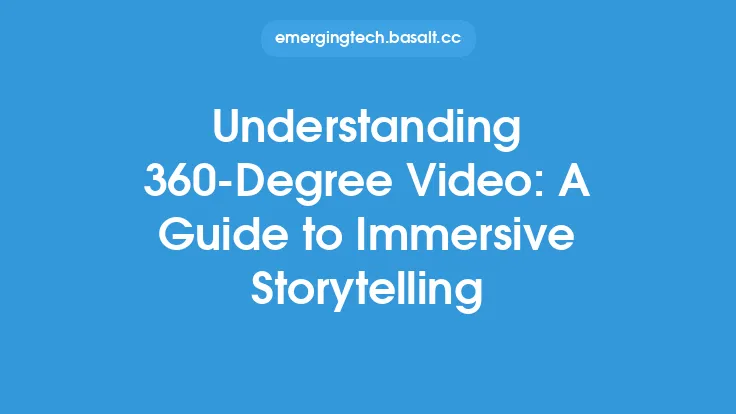Producing high-quality 360-degree video content requires careful planning, specialized equipment, and a thorough understanding of the production process. Unlike traditional video production, 360-degree video production involves capturing a complete sphere of footage, allowing viewers to see in all directions. This immersive format presents unique challenges and opportunities, and by following best practices and tips, creators can produce engaging and effective 360-degree video content.
Pre-Production Planning
Before starting a 360-degree video production project, it's essential to plan carefully. This involves developing a concept, script, and storyboard that take into account the unique aspects of 360-degree video. Creators should consider the viewer's perspective and how they will interact with the content. They should also plan for the technical requirements of 360-degree video production, including the type of camera equipment needed, the shooting location, and the lighting requirements. A well-planned pre-production phase helps ensure a smooth and successful production process.
Camera Equipment and Setup
The camera equipment used for 360-degree video production is specialized and typically consists of multiple cameras or a single camera with a 360-degree lens. The most common types of 360-degree cameras are monoscopic, which capture a single sphere of footage, and stereoscopic, which capture two spheres of footage to create a 3D effect. When setting up the camera equipment, creators should consider the field of view, resolution, and frame rate required for their project. They should also ensure that the camera is level and securely mounted to prevent camera shake and other issues.
Shooting and Capturing 360-Degree Footage
Shooting 360-degree footage requires a different approach than traditional video production. Creators should consider the viewer's perspective and how they will interact with the content. They should also be mindful of the camera's field of view and ensure that the subject is positioned correctly within the frame. When capturing 360-degree footage, it's essential to use a high frame rate and high resolution to ensure a smooth and detailed image. Creators should also consider using a camera stabilizer or gimbal to reduce camera shake and other issues.
Stitching and Editing 360-Degree Footage
After capturing 360-degree footage, the next step is to stitch the individual camera feeds together to create a single, seamless sphere of footage. This process is typically done using specialized software, such as Adobe After Effects or Blackmagic Design Fusion. The stitching process involves aligning the individual camera feeds, correcting for any errors or discrepancies, and blending the footage together to create a smooth and seamless image. Once the footage is stitched, creators can edit the 360-degree video using traditional video editing software, such as Adobe Premiere Pro or Avid Media Composer.
Adding Visual Effects and Sound Design
Adding visual effects and sound design to 360-degree video content can enhance the viewer's experience and create a more immersive and engaging environment. Creators can use specialized software, such as Adobe After Effects or Nuke, to add visual effects, such as text, logos, or graphics, to the 360-degree footage. They can also use audio editing software, such as Adobe Audition or Pro Tools, to add sound effects, music, or voiceovers to the content. When adding visual effects and sound design, creators should consider the viewer's perspective and how they will interact with the content.
Distribution and Playback
Once the 360-degree video content is complete, creators need to consider how it will be distributed and played back. There are several options for distributing 360-degree video content, including online platforms, such as YouTube or Vimeo, and offline platforms, such as VR headsets or mobile devices. Creators should ensure that their content is optimized for the chosen distribution platform and that it meets the technical requirements for playback. They should also consider using metadata, such as tags or descriptions, to help viewers find and interact with the content.
Technical Considerations
Producing high-quality 360-degree video content requires a thorough understanding of the technical considerations involved. Creators should be familiar with the technical requirements of 360-degree video production, including the resolution, frame rate, and field of view required for their project. They should also be aware of the limitations and challenges of 360-degree video production, such as stitching errors, camera shake, and audio sync issues. By understanding the technical considerations involved, creators can produce high-quality 360-degree video content that is engaging, immersive, and effective.
Conclusion
Producing high-quality 360-degree video content requires careful planning, specialized equipment, and a thorough understanding of the production process. By following best practices and tips, creators can produce engaging and effective 360-degree video content that takes advantage of the unique aspects of this immersive format. Whether used for entertainment, education, or marketing, 360-degree video content has the potential to revolutionize the way we experience and interact with media. As the technology continues to evolve and improve, we can expect to see even more innovative and immersive 360-degree video content in the future.





